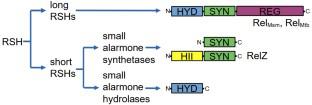Biochemistry (Moscow) ( IF 2.8 ) Pub Date : 2024-04-08 , DOI: 10.1134/s0006297924030027 Roman Y. Sidorov , Alexander G. Tkachenko

|
Abstract
The synthesis of (p)ppGpp alarmones plays a vital role in the regulation of metabolism suppression, growth rate control, virulence, bacterial persistence, and biofilm formation. The (p)ppGpp alarmones are synthesized by proteins of the RelA/SpoT homolog (RSH) superfamily, including long bifunctional RSH proteins and small alarmone synthetases. Here, we investigated enzyme kinetics and dose-dependent enzyme inhibition to elucidate the mechanism of 4-(4,7-dimethyl-1,2,3,4-tetrahydronaphthalen-1-yl)pentanoic acid (DMNP) action on the (p)ppGpp synthetases RelMsm and RelZ from Mycolicibacterium smegmatis and RelMtb from Mycobacterium tuberculosis. DMNP was found to inhibit the activity of RelMtb. According to the enzyme kinetics analysis, DMNP acts as a noncompetitive inhibitor of RelMsm and RelZ. Based on the results of molecular docking, the DMNP-binding site is located in the proximity of the synthetase domain active site. This study might help in the development of alarmone synthetase inhibitors, which includes relacin and its derivatives, as well as DMNP – a synthetic analog of the marine coral metabolite erogorgiaene. Unlike conventional antibiotics, alarmone synthetase inhibitors target metabolic pathways linked to the bacterial stringent response. Although these pathways are not essential for bacteria, they regulate the development of adaptation mechanisms. Combining conventional antibiotics that target actively growing cells with compounds that impede bacterial adaptation may address challenges associated with antimicrobial resistance and bacterial persistence.
中文翻译:

Erogorgiaene 的合成类似物抑制分枝杆菌 (p)ppGpp 合成酶的机制
摘要
(p)ppGpp 警报酮的合成在代谢抑制、生长速率控制、毒力、细菌持久性和生物膜形成的调节中起着至关重要的作用。 (p)ppGpp 报警酮由 RelA/SpoT 同源物 (RSH) 超家族的蛋白质合成,包括长双功能 RSH 蛋白和小报警酮合成酶。在这里,我们研究了酶动力学和剂量依赖性酶抑制,以阐明 4-(4,7-二甲基-1,2,3,4-四氢萘-1-基)戊酸 (DMNP) 对 (p )ppGpp 合成来自耻垢分枝杆菌的 Rel Msm和 RelZ以及来自结核分枝杆菌的 Rel Mtb。 DMNP被发现可以抑制Rel Mtb的活性。根据酶动力学分析,DMNP 作为 Rel Msm和 RelZ 的非竞争性抑制剂。根据分子对接结果,DMNP结合位点位于合成酶结构域活性位点附近。这项研究可能有助于开发警报酮合成酶抑制剂,其中包括 relacin 及其衍生物,以及 DMNP(海洋珊瑚代谢物 erogorgiaene 的合成类似物)。与传统抗生素不同,警报酮合成酶抑制剂针对与细菌严格反应相关的代谢途径。尽管这些途径对于细菌来说并不是必需的,但它们调节适应机制的发展。将针对活跃生长细胞的传统抗生素与阻碍细菌适应的化合物相结合,可能会解决与抗菌素耐药性和细菌持久性相关的挑战。



























 京公网安备 11010802027423号
京公网安备 11010802027423号